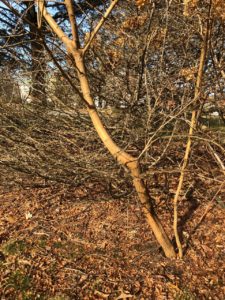 Bob Segal, volunteer with the Blackstone Parks Conservancy, is closely acquainted with white mulberry (Morus alba), a berried invasive tree originally from East Asia.
Bob Segal, volunteer with the Blackstone Parks Conservancy, is closely acquainted with white mulberry (Morus alba), a berried invasive tree originally from East Asia.
He’s removed many of them.
This year he dug up a dozen on the Boulevard and in Blackstone Park, their muscled roots frequently entwined with those of native trees. Thanks to an alert from the city forester, recently he cleared several crowding a black cherry and a young tulip tree (our official state tree that grows up to 80 feet tall).
White mulberry has a smooth slender trunk, yellowish-tan or even orange when young, and large shiny leaves that often have one or more deep notches.
“It is prized as a food source for the silkworm,” Bob notes, further explaining that it was introduced to New England in the 1600s to generate a silk industry. The silk effort failed, but the tree became a popular ornamental.
Birds widely distribute its berry seeds; the tree’s adaptability to most soils and weather aids its spread, and its quick-growing saplings press in on native trees and plants. Many states now consider it to be invasive.
Betsy Shea-Taylor



